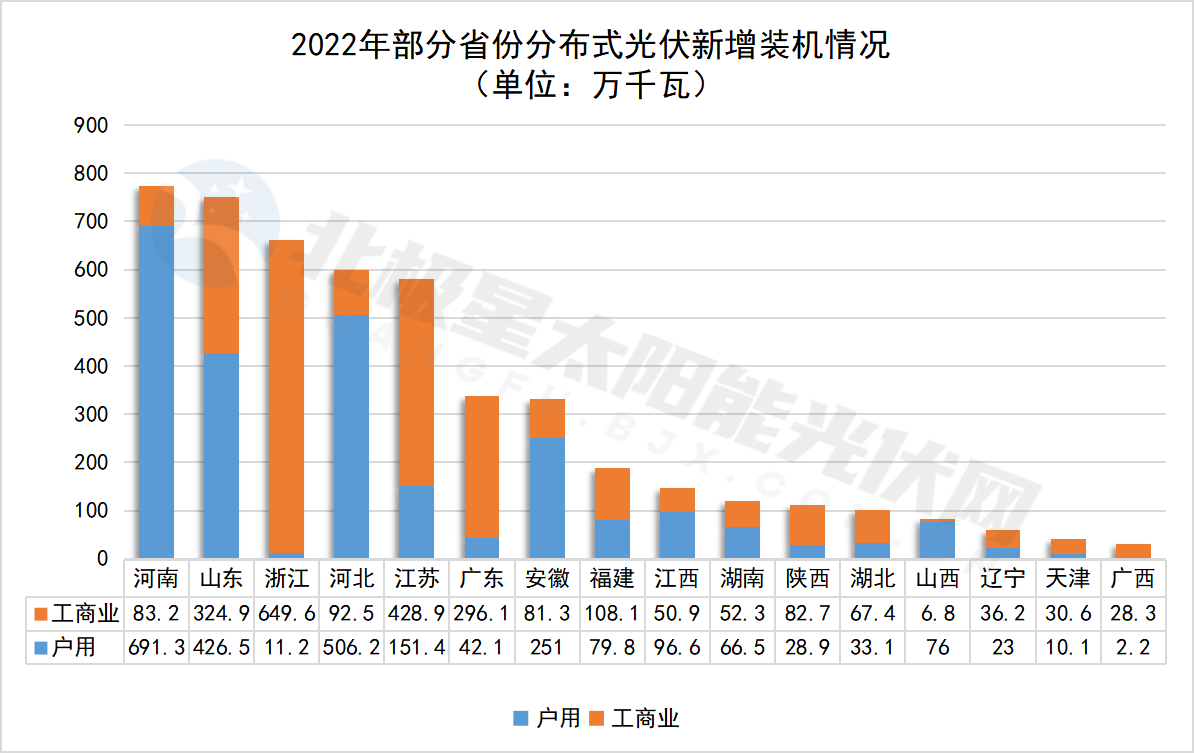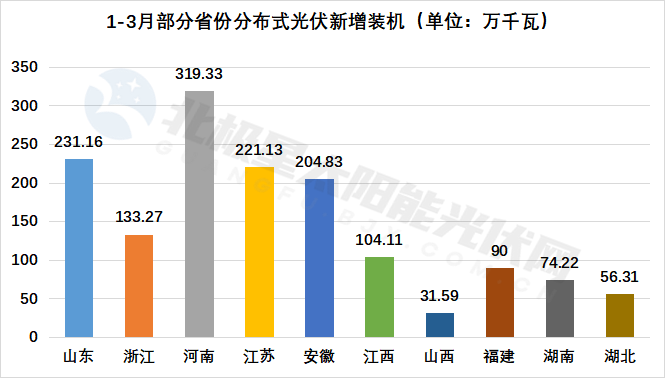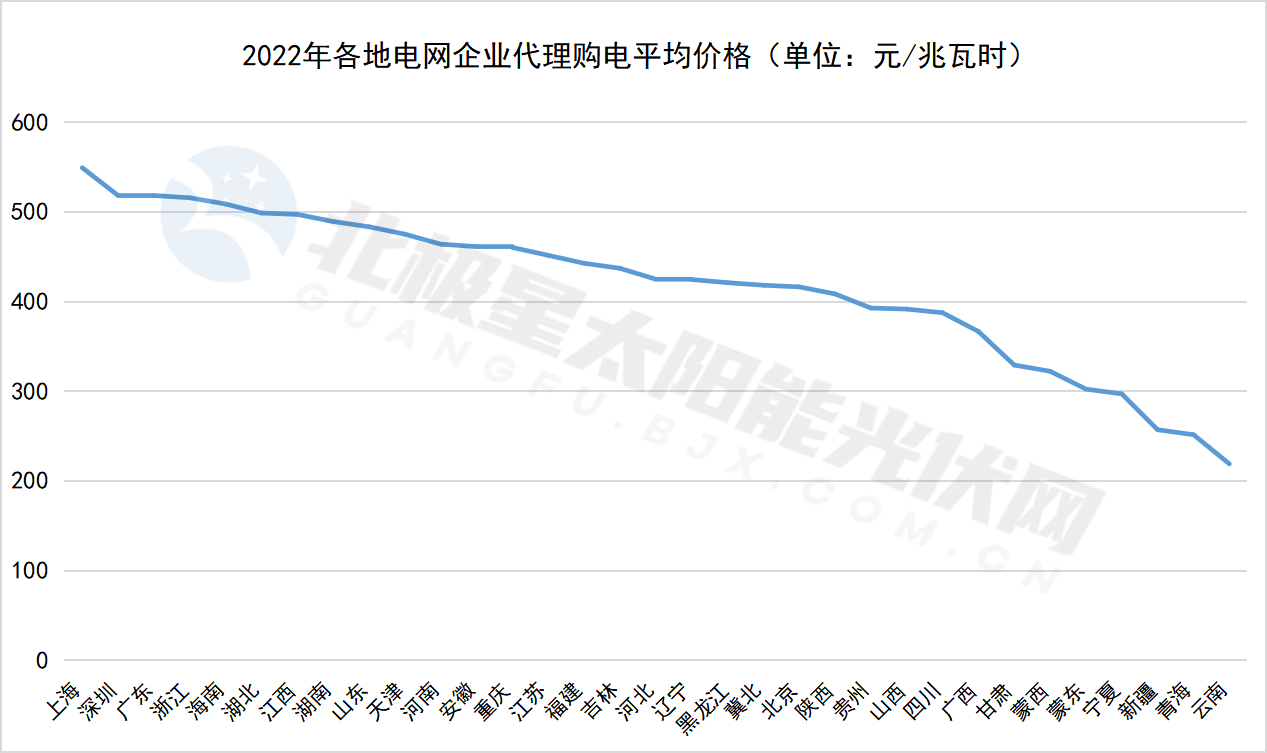Distributed photovoltaic "flying"
In the first quarter of this year, distributed photovoltaic continued the strong momentum of 2022. According to the State Grid New Energy Cloud, the newly added distributed photovoltaic installed capacity in the State Grid region alone exceeded 16.97GW, with a year-on-year growth of 52.99%. While the installed capacity has significantly increased, distributed photovoltaics have also shown some new characteristics.
Center of gravity moving south
In 2022, with the rapid rise of industrial and commercial distribution, it has become one of the main forces for installed capacity growth. The original distributed installation layout has also been broken, and the key markets for distributed photovoltaics are shifting from traditional Hebei, Henan, Shandong and other regions to the southeast regions of Zhejiang, Jiangsu, Guangdong, Anhui and other regions.

The latest data released by institutions such as the National Energy Administration also supports this viewpoint. For example, in Zhejiang and Jiangsu provinces with developed manufacturing and industrial and commercial industries, the new installed capacity of distributed photovoltaics in 2021 was less than 2 million kilowatts, and in 2022, the installed capacity data climbed to 6.608 million kilowatts and 5.803 million kilowatts, respectively. In the first quarter of this year, both provinces' new installed capacity of distributed photovoltaics also exceeded 1 million kilowatts, ranking among the top in the national grid region.

The deep implementation of the "dual carbon" goal in various industries is the main reason for this change in the market. The southeastern coastal region is the main manufacturing base in China, with a large number of enterprise factories and close to the load center. With the gradual increase of energy consumption dual control policies in various regions, all industries are facing zero carbon transformation. The use of rooftop resources to build distributed photovoltaic power stations is not included in the total energy consumption assessment, and can also alleviate its power rationing pressure. It is one of the paths suitable for most industries and easy to implement carbon reduction transformation.
Moreover, in the southeastern region, the electricity prices for general industrial, commercial, and large industrial transactions are even higher. According to statistics from the North Star Power Grid, from January to December 2022, the top five regions with average electricity purchase prices nationwide were Shanghai, Guangdong, Shenzhen, Zhejiang, and Hainan, all located in economically developed coastal areas in the southeast, with an average electricity purchase price of over 500 yuan/megawatt hour.

For power station investors, the increase in average electricity prices means a corresponding increase in the comprehensive electricity income and return rate of distributed photovoltaic power stations, which means "self use, surplus electricity connected to the grid". This has prompted development enterprises to focus their investment on these economically strong provinces in the southeastern coastal areas.
In addition, the local government's support in subsidies and other aspects is also an important reason for the rapid increase in distributed penetration rates in the southeastern region. It is understood that there are still subsidized areas for distributed photovoltaics, mainly concentrated in southeastern coastal areas such as Zhejiang, Jiangsu, and Guangdong. According to the public statistics of the North Star Solar Photovoltaic Network, as of now, there are 20 cities and counties in Zhejiang and 8 counties in Jiangsu, respectively, still providing subsidies for solar energy projects or initial installation.
The high electricity consumption, high electricity prices, and strong policy support have made the southeast coastal area a key layout for many distributed enterprises. According to a brand developer, "Starting from the second half of 2022, all distributed photovoltaic brands are expanding into markets such as Anhui, Jiangsu, Jiangxi, Zhejiang, Fujian, etc. Everyone is optimistic about the market potential of these provinces
The installation demand of small and medium-sized businesses has been activated
In terms of segmented markets, the installation demand of small and medium-sized enterprises has been activated, and the trend of the market sinking to a deeper level is very obvious.
Firstly, more and more distributed brands are starting to increase their focus on this niche track. For example, in 2022, Sunshine New Energy launched the "Galaxy Plan" to address the energy pain points in the industrial and commercial photovoltaic market, especially for small and medium-sized enterprises; Zhejiang Carbon Silver, which is rapidly rising in the household market, will also focus on the distributed field of small, medium-sized, and micro industries and commerce in its layout; Focusing on distributed Liansheng Power for small and medium-sized businesses, we have upgraded the "Zero Carbon New City Plan" to 2.0, providing systematic, diversified, and sustainable services such as distributed photovoltaic, smart energy storage, new energy charging, and green power trading for small and medium-sized users.
Secondly, in 2022, due to fluctuations in the industrial chain, the full investment and loan markets have been compressed. Many household agents and distributors have also begun to shift their business focus to the industrial and commercial distributed photovoltaic market due to shortcomings in financing channels.
Due to the similarity between the business model of small and medium-sized enterprises and the development and construction model of household photovoltaics, they can also learn from the development methods of household channels to expand their channels. These transformed household agents and distributors have quickly become new forces in the distributed development of small and medium-sized industry and commerce.
According to a brand dealer in Hubei, due to the compression of household business in various aspects, in 2022, with the support of the brand, the focus of business shifted to the industrial and commercial distributed photovoltaic market. Based on the accumulation and reputation of old customers, it quickly settled in the industrial and commercial photovoltaic market.
The data also confirms this point. According to media statistics, in 2022, there were 42768 registered projects in the national industrial and commercial industry, with a registered scale of less than 500kW accounting for 57%, 1-5MW accounting for 22%, and 0.5-1MW accounting for about 15%. Among them, the three major industrial and commercial provinces of Zhejiang, Guangdong, and Jiangsu all focus on small and medium-sized industrial and commercial projects. Distributed industrial and commercial projects below 1MW in Zhejiang account for 85%, over 75% of industrial and commercial projects in Guangdong are within 2MW, and industrial and commercial projects below 5MW in Jiangsu account for over 70%.
In fact, small and medium-sized enterprises, which account for more than 90% of the number of industrial enterprises in China, are facing the urgent need of low-carbon transformation under the hard indicators of "carbon peak, carbon neutrality" and "energy conservation, consumption reduction, energy conservation and efficiency increase". Among many low-carbon emission reduction paths, investing in distributed photovoltaic and using green power is one of the paths applicable to most industries and easy to implement, which can be predicted, Distributed photovoltaic technology for small and medium-sized enterprises in industry and commerce will become a new blue ocean in the market.
Wider path for additional benefits
With the gradual improvement of the electricity trading market, more distributed power station users can directly participate in carbon trading such as green power trading and CCER trading to obtain more additional benefits related to photovoltaic power generation.
It is understood that in 2022, Zhejiang incorporated a large amount of scattered distributed new energy into the green power market trading by allowing distributed power sources to participate in green power trading through aggregation. Since February 2022, 29 aggregators have represented nearly 2000 distributed power sources in Zhejiang Province, achieving 239 million kilowatt hours of green power trading.
Moreover, the transaction price of green electricity is generally higher than the average price in the local medium to long term market, which can bring higher income and profits to development enterprises and homeowners.
According to a Zhejiang listed company disclosed on an investor interaction platform, the company has signed a "Zhejiang Province Green Electricity Marketization Trading Entrustment Agreement" with an energy sales company under the State Grid. Some of the remaining electricity from self owned power stations is included in the green electricity trading, and the declared transaction price is 0.47 yuan/kWh, which is far higher than the local desulfurization coal benchmark price of 0.4153 yuan/kWh. The Beijing Electric Power Trading Center previously reported that the transaction price of green electricity is generally higher than the average price in the local medium to long term market, with a premium range of 20.53-105.52 yuan/megawatt hour.
In addition to green electricity trading, the improvement of carbon emission trading mechanisms is also an important means to increase the revenue of distributed photovoltaic and promote the development of distributed household photovoltaic. In April 2021, the Energy Data Center of Leqing City, Wenzhou City, Zhejiang Province launched a pilot project for the aggregation of distributed photovoltaic carbon assets. In November 2022, the carbon inclusive mechanism management measures were reviewed and approved, expanding another path for additional benefits for distributed photovoltaic.
According to an industry expert's calculation, taking an 8MW industrial and commercial distributed photovoltaic project in Hangzhou, Zhejiang as an example, if we choose to develop CCER, we will receive an additional income of 622128 yuan per year. If we choose to develop GCC, we will receive an additional income of 133952 yuan per year; If you choose to develop IRE, you will receive an additional income of 64000 RMB per year.
It is worth noting that recently, the first "one to many" distributed photovoltaic "partition wall electricity sales" pilot project in China was officially put into operation in Suzhou. The project's implementation may provide replicable and reference experience for the large-scale promotion of "partition wall electricity sales". In the future, with the establishment of the distributed partition wall electricity sales model, it will significantly improve the overall economic efficiency of distributed photovoltaic projects and also promote the better development of industrial and commercial distributed power stations.



